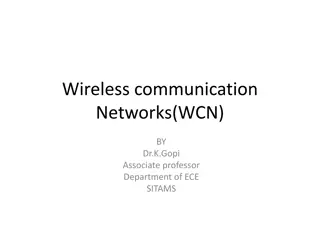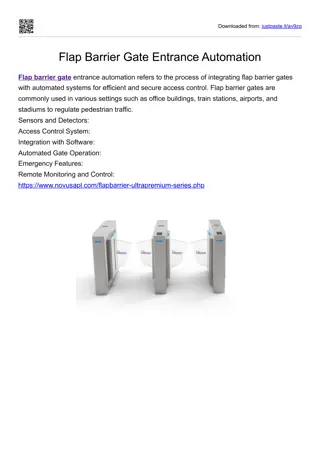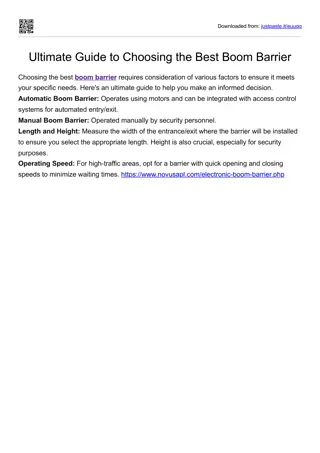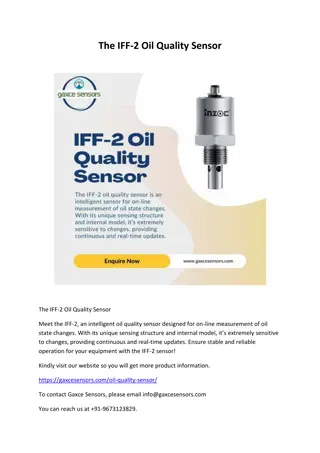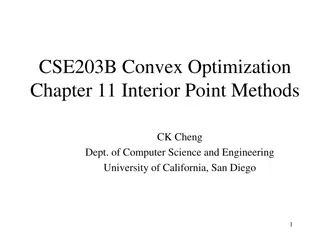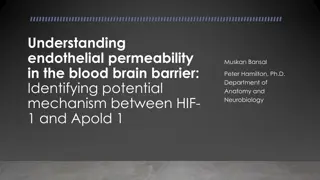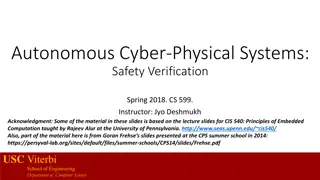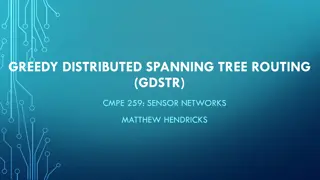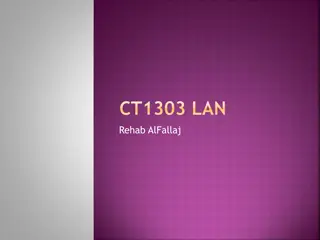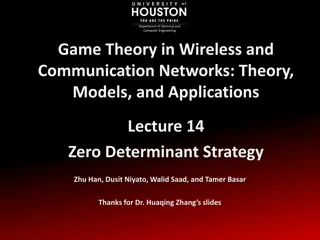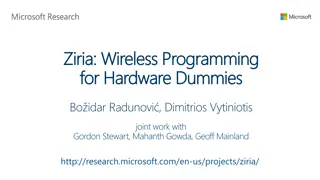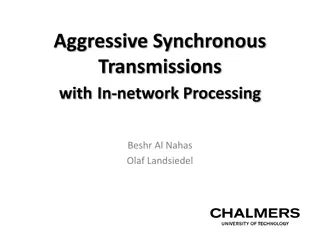Optimizing Barrier Coverage Quality in Wireless Sensor Networks
Explore the optimization of barrier coverage quality in wireless sensor networks, focusing on maximizing intruder detection, detection probability, and minimizing data transmission time. The problem is modeled graphically and solved using the Minimum Cost Maximum Flow Algorithm, with a background in k-Barrier Coverage and sink-connected barrier coverage. The article delves into network modeling, algorithm complexity analysis, and provides a detailed conclusion on achieving optimal barrier coverage quality.
Download Presentation

Please find below an Image/Link to download the presentation.
The content on the website is provided AS IS for your information and personal use only. It may not be sold, licensed, or shared on other websites without obtaining consent from the author. Download presentation by click this link. If you encounter any issues during the download, it is possible that the publisher has removed the file from their server.
E N D
Presentation Transcript
Barrier Coverage with Optimized Quality for Wireless Sensor Networks Yung-Liang Lai*, Jehn-Ruey Jiang National Central University Taoyuan Innovation Institute of Technology* Taiwan
Wireless Sensor based Barrier Coverage USA Wireless sensor
Barrier Coverage Optimization Problem How to construct a barrier coverage such that : Degree of Detecting intruders is Maximized , Probability of Detecting intruders is Maximized Data transmission time is Minimized?
Barrier Coverage Optimization Problem To optimize Quality of Barrier Coverage We define three Quality metrics detection degree, detection probability, expected transmission time We model the problem as a Graph Problem Solve it by the Minimum Cost Maximum Flow Algorithm
Outline Background Network Modeling Barrier Coverage Optimization Problem Optimal Barrier Coverage Algorithm Time Complexity Analysis Conclusion
Background k-Barrier Coverage Problem Sink Connected Barrier Coverage
k-Barrier Coverage Problem Degree (k) is the number of virtual detection lines How to select nodes to maximize degree (k) Solution: k=2 Given:
Sink Connected Barrier Coverage Sensor node (center dot) with a sensing area for detecting and forwarding events Sensor forwarding events Detection Line node for only Transmission Link Sink Node Boundary area Intruder
Outline Background Network Modeling Barrier Coverage Optimization Problem Optimal Barrier Coverage Algorithm Time Complexity Analysis Conclusion
Network Model Coverage Graph Gc Transmission Graph Gt
Coverage Graph (Gc) Ni and Nj have overlapped sensing coverage, then Edge (Ni, Nj) exists
Coverage Graph (Gc) Detection Probability depend on distance P(d)=e- d Distance (d) sensor target P(d) Dist Detection Quality Worst Case of P Pw(Si, Sj)=P( Dist / 2 ) S i S j Intruder Path in Middle (Worst Case)
Transmission Graph (Quality) <Ni, Nj> = node Ni can transmit data to Nj Detection Quality
Transmission Graph (Gt) Weight of edge on Gt Quality of Link: Packet size 1 S B ETT Ni,Nj = Bandwidth R Ni,Nj R Nj,Ni Successful Ratio of Sending Packet Successful Ratio of ACK Packet N3 N1 N2 N4 2 2 2 2 N14 K1 3 1 N11 N9 2 K2 N13 1 N10 3 2 N12 4 1 2 N5 N6 N8 N7
Transmission Graph (Gt) Quality of Path Set: Quality of Path Set: To measure the expected transmission time of a path set(PS) set(PS) path 1 |PS| h PSETT h N1 N2 2 ETT(PS) = N3 N4 2 2 2 N14 K1 3 1 N11 N9 2 K2 N13 1 N10 3 2 N12 4 1 2 N5 N6 N8 N7
Outline Background Network Modeling Barrier Coverage Optimization Problem Optimal Barrier Coverage Algorithm Time Complexity Analysis Conclusion
Barrier Coverage Optimization Problem (k,p,t) Barrier Coverage Optimization Problem How to select nodes from randomly deployed sensor nodes to reach three goals : Goal 1: Maximizing the degree k of barrier coverage Goal 2: Maximizing the minimum probability p of detecting intruders crossing the monitoring region Goal 3: Minimizing the expected transmission time t to send data to the sink nodes.
Outline Background Barrier Coverage Optimization Problem Optimal Barrier Coverage Algorithm Optimal Barrier Coverage Algorithm Backgroud: Maximum Flow Algorithm & Maximum Flow Minimum Algorithm Optimal Barrier Coverage Algorithm Time Complexity Analysis Conclusion
Background: Maximum Flow Algorithm Maximum Flow (MaxFlow) ALG Each edge is assigned capacity constraint To find some flows from s to t , such that: Number of Flow is Maximized Maximum Flow Plan = 2 Flows capacity Flow on edge
Background: Maximum Flow Algorithm Maximum Flow (MaxFlow) ALG To find MaxFlow plan from s to t , such that: Number of Flow ( ) is Maximized 2 Flows
Background: Maximum Flow Minimum Cost Algorithm Maximum Flow Minimum Cost (MaxFlowMinCost) ALG To find flows from s to t , such that: $1 $1 $2 $3 $1 $1 $1 $2 capacity Flow value
Background: Maximum Flow Minimum Cost Algorithm Maximum Flow Minimum Cost (MaxFlowMinCost) ALG To find flows from s to t , such that: Number of Flow( ) is Maximized Total Cost ($) is Minimized $1 $1 $2 $3 $1 $1 $1 $2 capacity Flow value
Optimal Barrier Coverage Algorithm Basic Idea : 3 Phases Phase1)To find a set of nodes (FP) with maximized number of node-disjointed flows (k) in Coverage Graph (Gc) by MaxFlow ALG Phase2)To refine FP such that minimum detection probability (p) is maximized by MaxFlow ALG Phase3)To select some additional nodes for connecting sink nodes with minimized Expected Transmission Time (t) by MaxFlowMinCost ALG
Phase1 To find a set of nodes (FP) with maximized number of node-disjointed flows (k) in Coverage Graph (Gc) by MaxFlow ALG K=2
Phase 2 (Repeatedly remove edges such that minimum detection probability (p) is Maximized without loss number of flows in Phase 1 Quality of Barrier Coverage = 0.4 Quality of Barrier Coverage = 0.5 N2 N2 N1 N3 N1 N3 N4 N4 0.7 0.6 0.7 0.6 0.6 0.6 X N9 N9 N5 0.6 N5 0.6 0.5 0.5 N6 N6 N7 N7 N8 N8 0.6 0.6 0.4 0.6 0.6 Minimum detection probability =0.5 Minimum detection probability =0.4
Phase 3 To select some additional nodes for connecting sink nodes with minimized Expected Transmission Time (t) by MaxFlowMinCost ALG (5) (4) (2) (4) N3 N1 N2 N4 N3 N1 N2 N4 2 2 2 2 2 2 2 2 N14 K1 3 1 K1 3 1 N11 2 K2 N11 N9 2 K2 N9 1 1 3 2 3 2 N13 N13 N12 N12 N10 N10 4 4 1 1 2 2 N5 N6 N5 (2) N8 N7 N8 N6 N7 (5) (5) (3) Expected Transmission Time = (5+4+4+2 + 2+5+5+3)/8 , which is Optimized
Optimal Barrier Coverage Algorithm Step 1: Construct a coverage graph Gc Each edge is associated with a weight (detection probability) N2 N1 N3 N4 0.7 0.6 0.6 N9 0.5 N5 0.5 N6 N7 N8 0.6 0.4 0.5
Optimal Barrier Coverage Algorithm Step 2: Execute to Node-Disjoint Transformation transfer Gc into the new graph Gc* For Multiple-in & Multiple-Out Node-Disjoint Transformation
Optimal Barrier Coverage Algorithm Step 3:(To Find Maximum barrier coverage) Execute the maximum flow algorithm on Gc* to decide the maximum flow plan FP N2 N1 0.6 N3 N4 0.7 0.6 T S N9 0.5 N5 0.5 N6 N7 N8 0.6 0.4 0.5
Optimal Barrier Coverage Algorithm Step 4: Remove all edges with the minimal probability without loss of Degree(k) Can we remove the MIN edge without loss number of flows? Yes, remove it and continue to test No, quality is maximized S T 0.6 0.5 0.6 0.6 0.4
Optimal Barrier Coverage Algorithm Step 4: Remove all edges with the minimal probability without loss of Degree(k) Can we remove the MIN edge without loss number of flows? Yes, remove it and continue to test No, quality is maximized S T 0.6 0.5 0.6 0.6 0.4
Optimal Barrier Coverage Algorithm Step 4: Remove all edges with the minimal probability without loss of Degree(k) Can we remove the MIN edge without loss number of flows? Yes, remove it and continue to test No, quality is maximized S T 0.6 0.5 0.6 0.6 A Barrier is constructed with MIN_Quality=0.5
Optimal Barrier Coverage Algorithm Step 5: Construct a transmission graph Add a virtual source node S and a virtual target node T S T
Optimal Barrier Coverage Algorithm Step 6: For each node selected in Step. 4, add an edge from S, For each sink node, add edge to T The ETT (Expected Transmission Time) is assigned on each edge S T
Optimal Barrier Coverage Algorithm Step 7: Execute Maximum Flow Minimum Cost Algorithm Maximum Flow with Minimized Cost S T Thus, a node set with maximized degree (k), maximized minimum_detection_probability (p), and minimized average transmission time (t) is determined
Time Complexity Analysis Time complexity of Optimal Barrier Coverage Algorithm is dominated by step 4 Try to remove minimum weight edge on coverage graph and to execute maximum flow algorithm, repeatedly (in step 4) Time complexity in step 4: O(E V E2)= O(V E3) E is the number of edges, Maximum flow algorithm needs O(V E2)
Conclusions Barrier Coverage with Optimized Quality Problem is molded and solved in this paper Aiming at this problem, we proposed a Optimal Barrier Coverage Algorithm (OBCA) The OBCA is time-efficient (polynomial time complexity)



